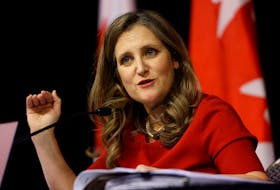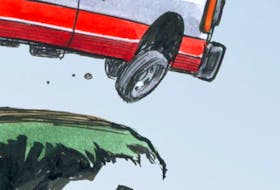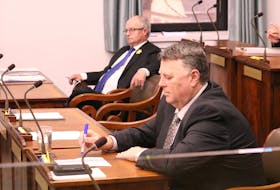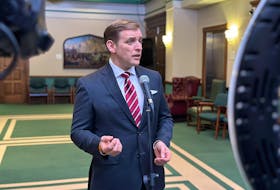Justin Trudeau beguiled the television networks into giving him free airtime to address an issue of “urgent national importance.”
In the event, he delivered a political broadcast on behalf of the Liberal Party, a specious reiteration of the throne speech delivered hours earlier by the Governor General.
The move may yet backfire on the prime minister. In a poll earlier this month, more than half of respondents said they didn’t know Erin O’Toole well enough to say whether they had a positive or negative impression of the new Conservative leader. Many more will know him now, following his own national address.
It was at least a reminder that, while the speech from the throne is commonly depicted as a vision statement, it is in reality an overtly political document, designed in this case to wrest control of the narrative from the opposition parties.
The Liberals suffered a torrid summer as parliamentary committees delved into the WE charity affair.
The throne speech offered the government the chance to draft a new agenda that the opposition parties will be forced to support or vote down.
By making the plan as generous as possible – witness the extension of the Canada Emergency Wage Subsidy until an unspecified date next summer – the government has all but guaranteed it will not be defeated over the throne speech.
NDP leader Jagmeet Singh said the speech didn’t go far enough but it would be a shock if he decides to vote against such a profligate manifesto.
The CEWS extension will add to a deficit already pushing $400 billion (since its inception in March, CEWS has cost $35 billion, so it is reasonable to assume it will pile another $50 billion on to the national debt, if applied to all sectors.)
Yet it will likely be a wildly popular move. As the number of new COVID cases continue to rise – over the past seven days we have seen 1,123 new cases, compared to 380 in mid-August – confidence in in short supply.
But was retaining CEWS for another nine months the best use for $50 billion? There is a case to be made that the funds should be targeted at those industries that have been hardest hit – the restaurant business, for example.
But good luck to the political leader who calls for more restrained spending.
We already know the Liberal line of attack. “This is not the time for austerity,” said Gov. Gen. Julie Payette.
The speech claimed that the government will continue to be guided by “the values of sustainability and prudence” yet there was no indication of due diligence or concern about the level of deficit spending.
The prevailing theory in Liberal circles is that interest rates are so low that governments are obliged to lock in and borrow without remorse. Since the Bank of Canada holds 60 per cent of all outstanding Government of Canada securities, we can afford to risk upsetting international markets, the thinking goes.
But as former Liberal advisor Robert Asselin pointed out, the Bank’s quantitative easing is a temporary measure to boost demand and make sure rates stay low during the crisis. “The idea that the Bank of Canada will continue to buy billions in government bonds indefinitely is false,” he said.
The message does not seem to have percolated to his former colleagues.
The throne speech promises a hectic fall agenda – and the spending implications are eye-watering.
It’s not that the measures proposed are undesirable. But the question is: are they necessary? Do they contribute more to growth than debt? One area that would have passed that test would have been a concrete commitment to roll out rural broadband, to support people who have struggled to work from home without fast and affordable Internet.
The government said it would “accelerate” its broadband roll out but as Matt Hatfield of the Open Media campaign pointed out, how do you accelerate something that has fallen so far behind?
“There’s no sign our government is acting on the urgency of Canada’s growing digital divide,” he said.
All governments look at things through a political lens – this one more than most.
The Trudeau Liberals have promised to get to net zero emissions by 2050, a commitment made without much thought to the implications for the country’s biggest source of export revenue – the oil and gas industry. Internally, the Liberals are said to have resolved that net zero cannot be achieved if oil and gas production is allowed to increase, so the plan is to use regulation to limit growth – a decision made without regard to the balance of payments.
This kind of woolly thinking permeates the throne speech. The government promises “significant, long-term and sustained investments” in a Canada-wide early learning and childcare system.
Paul Martin’s Liberal government tried something similar 15 years ago. Ken Dryden, the social development minister, eventually signed up all the provinces, but only on the condition that Ottawa handed over the cheque and then minded its own business.
Since then Quebec has built out its own subsidized daycare system and is unlikely to participate in a national program, even though it will demand any funding that is going.
Getting women back into the workforce is critical. Female participation in the labour force dipped below 55 per cent in April, for the first time since the mid 1980s. Employment among single mothers fell 12 per cent between February and June. Reversing those trends is urgent but it’s far from clear that negotiating a national daycare strategy with the provinces is the answer – after all, it took a year to come to an agreement last time around.
This throne speech is a clever political document
But then, the intent in the throne speech is to propose measures, rather than implement them.
With such a busy agenda, the government will be talking about things it wants to talk about.
One of those measures will be a plan to exceed Canada’s 2030 climate goals, the Governor General said.
The last time the Parliamentary Budget Officer looked at the government’s climate plan, Canada was on course to miss its Paris target by 79 million tonnes of greenhouse gas emissions. The speech contained some clues about how this gap might be filled – the energy efficient retrofitting of homes and buildings, investments in zero-emissions vehicles and nature-based solutions like tree-planting.
But we will have to wait on ministerial mandate letters and the government’s economic response plan later this fall to get a better sense of the level of ambition.
(Every indication is it will be in line with the final report by the Taskforce for Resilient Recovery that came out last week and suggested spending $55.4 billion over five years for many of these measures, including around $27 billion for retrofits – a plan that would cut, coincidentally, 79 million tonnes of greenhouse gas emissions.)
Again, opposition leaders will have to support a proposal that could create thousands of jobs in the construction industry, or propose an alternative.
It is a strategy that has worked for the Liberals in the past – promise Canadians the sun, the moon and the stars, and then contrast that with the more tight-fisted, terrestrial offerings made by the opposition.
This throne speech is a clever political document. But it takes our current prosperity for granted and does little to promote long-term growth.
• Email: [email protected] | Twitter: IvisonJ
Copyright Postmedia Network Inc., 2020








